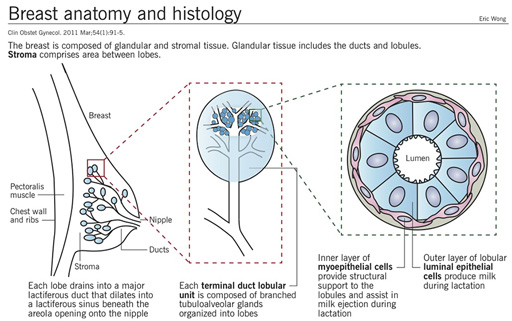2.1 Secretion: functions of the breast
The breast is another example of a secretory tissue.
Structurally, the breast consists of a number of lobes connected by lactiferous (milk-carrying) ducts to the nipple. Each lobe is a compound gland branching into lobules and alveoli lined with epithelial cells, which are supported in a loose matrix of connective tissue. The connective tissue includes accumulations of adipocytes (fat cells).
During pregnancy the duct system and alveoli expand considerably as the epithelial cells lining the alveoli are responsible for milk secretion. At this time the connective tissue is correspondingly reduced. The alveoli are surrounded by contractile cells (myocytes), which put pressure onto the alveoli to promote milk secretion.
After weaning, when breast milk is no longer required, the alveoli regress, leaving just the duct system in place.
Activity 2
Open the virtual microscope [Tip: hold Ctrl and click a link to open it in a new tab. (Hide tip)] in a new window or tab. Find Slides 2 and 3 in the ‘Week 3’ category.
Spend a few minutes comparing the histology of a normal breast (Slide 2) and a lactating breast (Slide 3). Notice the expansion of the alveoli and the secretory epithelium in the lactating breast. These sections demonstrate how a tissue can vary greatly in its histological appearance as a result of normal physiological changes.

